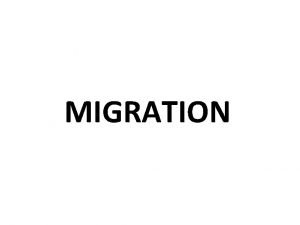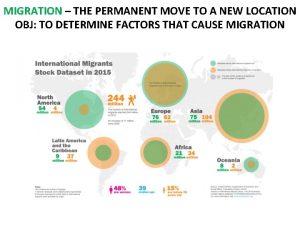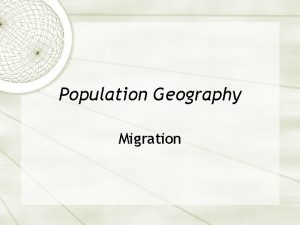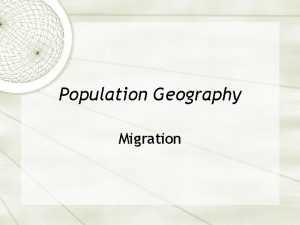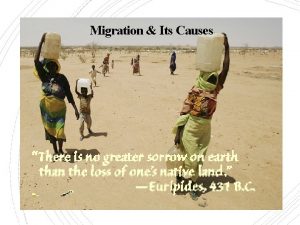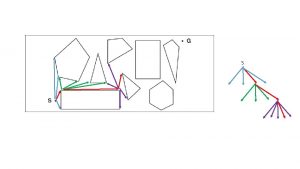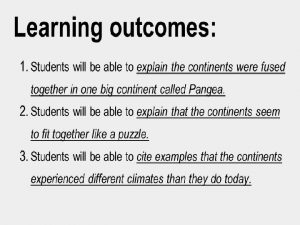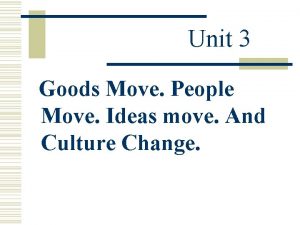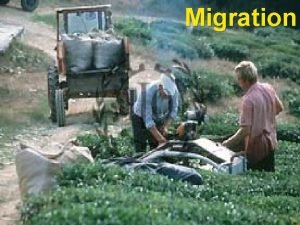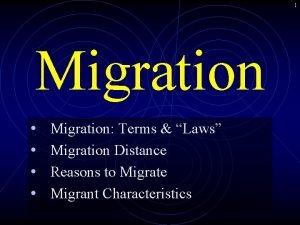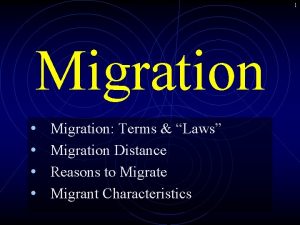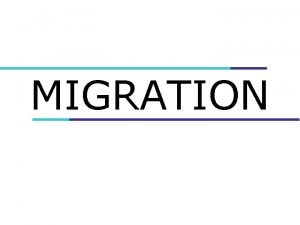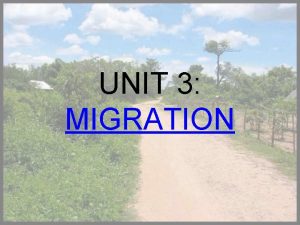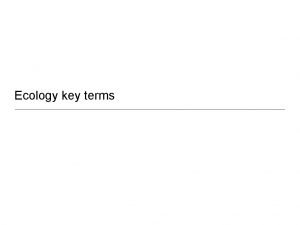Migration Key Terms for Migration a permanent move


































- Slides: 34

Migration Key Terms for Migration: a permanent move to a new location Emigration: migration from a location Immigration: migration to a location Net migration: the difference between the number of immigrants and the number of emigrants Mobility: all types of movement from one location to another Circulation: movements that recur on a regular basis -daily, monthly, annually, seasonally

Migration Four Key Issues of Migration: 1. Why Do People Migrate? 2. Where Are Migrants Distributed? 3. Why Do Migrants Face Obstacles? 4. Why Do People Migrate Within A Country?

Migration Why Do People Migrate? Reasons For Migrating Push Factor: induces people to move away from their present location Pull Factor: induces people to move into a new location -people decide to migrate because of push and pull factors -both usually play a role in migration

Migration

Migration Three Major Kinds of Push and Pull Factors: 1. Economic 2. Cultural 3. Environmental

Migration Economic Push and Pull Factors Most people migrate for economic reasons -usually want to leave places with few job opportunities -go to places where jobs seem to be available -most 19 th century European immigrants to the United States came for economic opportunities -U. S. now attracting immigrants from Asia and Latin America -natural resources such as petroleum or uranium can also attract many immigrants

Migration Cultural Push and Pull Factors Two Kinds of Forced Migration: 1. Slavery 2. Political Instability 3. -new boundaries often find certain ethnic groups on the “wrong side” 4. -wars force certain ethnic groups to leave

Migration Refugees: people who have been forced to migrate from their home and cannot return for fear of persecution because of their race, religion, nationality, membership in a social group, or political opinion (UN definition)

Migration Refugees have no home until another country agrees to allow them in, or improving conditions make it possible to return to their former home -are homeless in the interim In 2001, more than 35 million refugees (U. S. Committee of Refugees) -15 million forced to migrate to another country -20 million forced to immigrate to another region within the same country

Migration Two Largest Groups of International Refugees: 1. Palestinians: people who left Israel after the country was created in 1948, or who left territories captured by Israel in 1967 2. -Golan Heights and West Bank

Migration

Migration

Migration

Migration 2. Afghans: the result of civil war since 1979

Migration Largest Two Groups of Internal Refugees: 1. Sudanese—over 4 million refugees from civil war

Migration 2. Angola—civil war has caused over 1 million deaths and over 2. 5 million internal refugees

Migration Environmental Push and Pull Factors People are pushed from hazardous areas to physically attractive ones Attractive environments include: mountains, seasides, and warm climates (Rocky Mountains, Alps, Mediterranean Sea, Florida…)

Migration Many people have moved to Arizona because of bronchitis, asthma, and allergies because of its dry climate -pollen count in Tucson has increased 3500% since 1940 s -two-thirds of pollen count comes from 3 types of vegetation that has been imported by the migrants -mulberry tree -olive tree -Bermuda grass Some areas have banned these species, but it is very difficult to eradicate them

Migration Water-related disasters have forced people to leave certain areas floodplain: the area of a river subject to flooding during a specific number of years based on historical trends i. e. — “ 100 -year floodplain” means people living in this area can expect flooding once every century

Migration Lack of water can also push people from their land i. e. —Sahel region of Africa is experiencing chronic drought conditions which have forced hundreds of thousands of people to migrate -people in this area are traditional pastoral nomads, but growing populations and drought have forced people to migrate away

Migration

Migration During the 1930 s in the U. S. , the Dust Bowl occurred -drought conditions and strong dry winds buried farms under several feet of sandy dust -thousands forced to abandon their farms, many migrated to California -they were known as “Okies” “The Grapes of Wrath” by John Steinbeck (1938) depicts the plight of the Okies

Migration Intervening Obstacles: an environmental or cultural feature that hinders migration Before modern transportation, environmental features such as deserts, mountains, and large bodies of water halted migrations Transportation improvements such as motor vehicles and airplanes have diminished the importance of environmental features as intervening obstacles

Migration E. G. Ravenstein: 19 th century geographer who developed 11 laws of migration He made TWO main points about the distance that migrants travel: • Most migrants relocate a short distance and remain within the same country • Long distance migrants to other countries head for major centers of economic activity International migration: permanent movement from one country to another Internal migration: permanent movement within the same country

Migration Two Types of Internal Migration 1. Interregional migration: movement from one region of a country to another 2. -usually from rural to urban in search of jobs 2. Intraregional migration: movement within one region of a country 3. -usually within urban areas from older cities to newer suburbs

Migration Two Types of International Migration: 1. Voluntary migration: implies that the migrant has chosen to move for economic opportunity 2. Forced migration: the migrant has been compelled to move because of cultural factors 3. -has historically occurred because of slavery or political instability 4. *push/pull factors usually induce voluntary migration 5. *cultural factors normally compel forced migration

Migration Zelinsky’s Immigration Transition -associated with stages of the demographic transition Stage I: very little permanent migration although much daily and seasonal movements in search of food Stage II: most international migration and interregional migration Stage III and IV: mostly internal migration Societies in Stage III and IV of the demographic transition are the destinations of the internal migrants leaving Stage II countries in search of economic opportunities

Migration The principal form of internal migration within countries in stages III and IV of the demographic transition is intraregional, mostly from cities to surrounding suburbs Ravenstein noted that: *Most long-distance migrants are male *most long-distance migrants are individual adults rather than families with children

Migration From 1800 -1990, most international immigrants to the U. S. were males -males were more likely to be employed Since 1990, 55% of immigrants to the U. S. have been women

Migration During the 1980 s, 85% of Mexican immigrants without proper documentation to the U. S. were males -but, by 1991, women accounted for 50% of undocumented immigrants from Mexico to the U. S.

Migration About 40% of U. S. immigrants are between 25 and 39 years of age (23% of U. S. population in this range) Immigrants less likely to be over 65 years of age Increasing number of immigrants under age 15 Recent immigrants to the U. S. have attended school for fewer years and are less likely to have high school diplomas than American citizens

Migration Most Mexican immigrants come from rural areas and relocate in California (50%), Texas (20%), or other southwestern states Most Mexican migrants come from far inland, where economic conditions are worst -there are more jobs available near the U. S. border American employers hire undocumented immigrants because they can pay them lower wages and do not need to provide healthcare, retirement, or other benefits -also easier to terminate unsatisfactory workers

Migration

Migration
 Difference between immigration and emigration
Difference between immigration and emigration Lateral thinking brain teasers
Lateral thinking brain teasers A permanent move to a new location is
A permanent move to a new location is Polynomial degrees and terms
Polynomial degrees and terms Unlike terms
Unlike terms Example of business model
Example of business model Key partners
Key partners Fspos
Fspos Typiska drag för en novell
Typiska drag för en novell Nationell inriktning för artificiell intelligens
Nationell inriktning för artificiell intelligens Returpilarna
Returpilarna Varför kallas perioden 1918-1939 för mellankrigstiden?
Varför kallas perioden 1918-1939 för mellankrigstiden? En lathund för arbete med kontinuitetshantering
En lathund för arbete med kontinuitetshantering Adressändring ideell förening
Adressändring ideell förening Tidbok
Tidbok Anatomi organ reproduksi
Anatomi organ reproduksi Densitet vatten
Densitet vatten Datorkunskap för nybörjare
Datorkunskap för nybörjare Stig kerman
Stig kerman Debattartikel mall
Debattartikel mall Delegerande ledarstil
Delegerande ledarstil Nyckelkompetenser för livslångt lärande
Nyckelkompetenser för livslångt lärande Påbyggnader för flakfordon
Påbyggnader för flakfordon Tryck formel
Tryck formel Svenskt ramverk för digital samverkan
Svenskt ramverk för digital samverkan Urban torhamn
Urban torhamn Presentera för publik crossboss
Presentera för publik crossboss Teckenspråk minoritetsspråk argument
Teckenspråk minoritetsspråk argument Vem räknas som jude
Vem räknas som jude Treserva lathund
Treserva lathund Epiteltyper
Epiteltyper Claes martinsson
Claes martinsson Cks
Cks Byggprocessen steg för steg
Byggprocessen steg för steg Mat för unga idrottare
Mat för unga idrottare
